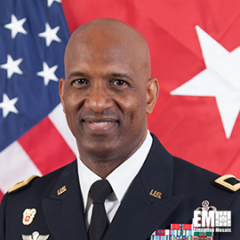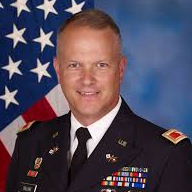Speakers
3 speakers
Date & Time
Apr 14, 2022 2:00 p.m. ET
Webinar
Date: On demand
Duration: 1 hour
Cost: No Fee
Maj. Gen. Rob Collins, the Army’s program executive officer for command, control, communications–tactical (PEO C3T), lays out the direction of the Army, and really all of the Defense Department, in simple terms.
“The difference between a great decision, a good decision and a poor decision will be milliseconds in the future battlespace,” Collins said on Ask the CIO.
With data coming in from thousands of sensors on the ground in the air and in space, commanders need more help than ever sorting through the wave of information.
“We have to make sure that we’ve got a fabric that can ingest all the data, make sure it is understandable, it’s interoperable and it’s trusted. Then, on the other end, we have to make sure it’s discoverable,” Collins said. “Traditionally, we’ve embraced what we would describe as a publish-and-subscribe type of an environment. We’re now trying to pivot toward a more federated data environment. You can discover data, you can exchange data based on the need for that data, and you’re able to articulate and mark data to the attribute level.”
Creating that data fabric is part of what Brig. Gen. Jeth Rey, director of the Army’s network cross-functional team, is focused on.
Rey said the Army traditionally has had data fabrics at the enterprise level, but only in the last year or so did they see a need for this concept at the tactical edge and for it to work as part of the unified network.
“Without a data fabric, [the idea of] sensor-to-shooter is just not going to be realized,” Rey said. “From the Joint All-Domain Command and Control (JADC2) perspective, where we bring in all of us sensor-to-shooter information, we have to be able to aggregate all that data using artificial intelligence and machine learning to really get after the data and present it to a commander so they can make informed decisions. That’s really the proposal that we’re putting on a table for all our industry partners to assist us in getting to that instinct.”
DoD’s 5 data decrees
The data fabric at the tactical edge, JADC2 and a host of other strategies and initiatives are part of DoD’s move toward a data-centric approach to the battlefield.
Deputy Secretary Kathleen Hicks signed a memo in May, laying out five “data decrees” to “generate transformative proficiency and efficiency gains across the DoD Data Strategy’s focus areas.”
The Army is updating its 2019 data strategy with Secretary Christine Wormuth offering some initial insights in a Feb. 8 message to the force.
“My second objective is to ensure the Army becomes more data-centric and can conduct operations in contested environments, which will enable our ability to prevail on the future battlefield,” she wrote. “Doing so will allow us to embrace emerging technologies to become a more effective and efficient force that can project power in cyberspace and defend our networks, weapons, and data from cyber threats.”
Collins and Rey are part of the leadership group charged with meeting Wormuth’s second goal.
“The proposal that we’re making across the board is, let’s be more data-centric, let’s have more cloud instances around the world, use more robust transport to get to our data, and reduce the complexity on the transport. Today, we continually secure our transport, but not our data,” Rey said. “If we secure our data, we reduce the complexity on the transport, and that will allow us to reach it using a zero trust architecture. We can get to the data and render it using identity management and attribute-based access control. That’s the key.”
Data elements as Lego blocks
Collins added the data fabric will include the metadata to help create and manage the attribute based access under the zero trust architecture.
He said that will help relieve the burden of exchanging data across tactical networks, which may be more disconnected, intermittent and work on limited bandwidth.
“As we start to go toward the data fabric, one of the areas that we’re specifically looking at is the data synchronization, and how do we do that,” Collins said.
Collins compared the data fabric to creating a common set of Lego blocks that fit together in a way that makes accepting data, sharing data, controlling data and applying AI and machine learning easier.
“In our operational environment, there’s a lot of different types of data. There is structured data, semi-structured data and unstructured data, and then as you start to look at all of the capabilities we have out in our current force – that come in different types of formats and structures – once you bring the data in, you’ve got to be able to persist the data and secure the data. We’ve also got to be able to synchronize the data across the Army environment at a unique velocity and a unique scale.”
Project Convergence driving change
The need for a data fabric and what is required to create one to support the tactical edge was one of several were all inputs that came from the initial exercises the Army conducted as part of Project Convergence, the Army’s contribution to JADC2.
“We’re able to take a couple of different data fabrics, one from commercial industry, one that’s actively employed as part of our cyber community, and one from our science and technology community, and we’re able to pursue the best of breed approach from each one of those activities and adopt that as part of our next capability set,” Collins said.
“For each one of those Lego blocks, we were able to find which the best components of that, assemble that were and then use that while our soldiers and continue to iterate this. We are able to try before we decide and buy, and then continue this iterative approach as we get ready to move forward, which is much different than the previous strategy. That was more of a big bang theory where we tried to wait until everything was mature and then embrace and adopt technology all at a singular moment in time. Now we can iterate that as it is it matures and it’s ready.”
Rey added Project Convergence also helped the Army understand how to combine the tactical and enterprise data fabrics to create a unified network as a way to get closer to a JADC2 environment.
The Army is preparing for Project Convergence ‘22 and developing capability sets for 2025 and 2027.
Soldiers influencing Army’s capabilities set
This year the Army is bringing in coalition partners as part of the environment to test out how best to share information in a more integrated approach.
“We’ve completed our design goals, and coming up this April, we’re getting ready to do our critical design, which comes with a lot of technical exchange meetings that we do with industry. It’s really part of our twice a year process that we go out to industry, give them some of the hard problems that we’re trying to solve, and allow them to come in with some of our solutions,” Collins said.
“One of the other things that we’re starting to do is go out and do a lot of soldier touch points. We put the capability and equipment in the hands of the soldier and that allows us to get some feedback on how we’re starting to employ those capabilities. A lot of that process is underway, specific to Capability Set 23, and we’ve really started to focus in on how we’re going to increase the capacity and the resiliency within our network.”
Collins added through Project Convergence and by letting soldiers use the technology, they can more quickly assess the maturity of the capabilities in an operational environment. Additionally, the experiment lets the Army and its partners decide how affordable these technologies are and how much future budget planning is needed to field these capabilities on a larger scale.
“Working with Gen. Rey, we also start to determine our design goals for what we’re focused in on for Capability Sets 25 and 27. We start to look at some of the functions of protecting, starting with how we automate and make sure that we’re ready for our multi domain capable force of 2028,” he said.
“We’re setting the foundation for the initial data fabric. We have spent a fair amount of time looking at artificial intelligence sensor-to-shooter and weapons pairings, but even more important to commanders — and we’ve even seen this from real world employments — is those other elements of intelligence and logistics. They are front and center when it comes to what operational commanders need from a data perspective. And this is not about replacing the human in the loop with these artificial intelligence algorithms. It’s about augmenting, strengthening and empowering our commanders and leaders to make better decisions, faster decisions, and really getting inside what we call the OODA Loop — the ability to observe, orient, decide and act — and to be able to do that faster, with more clarity, with more accuracy than our adversary and give us an operational advantage on the future battlefield.”
Learning objectives:
- PEO C3T Priorities
- Data Management
- The usage of Emerging Technologies
- Priorities for the Future
This program is sponsored by 

Complimentary Registration
Please register using the form on this page or call (202) 895-5023.
Speakers

Brig. Gen. Jeth Rey
Director, Network Cross-Functional Team, Army

Maj. Gen. Rob Collins
Program Executive Officer, Command, Control, Communications-Tactical, Army

Jason Miller
Executive Editor, Federal News Network
Please register using the form on this page.
Have questions or need help? Visit our Q&A page for answers to common questions or to reach a member of our team.
